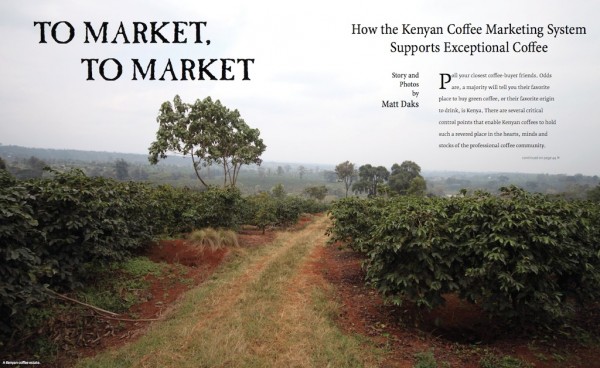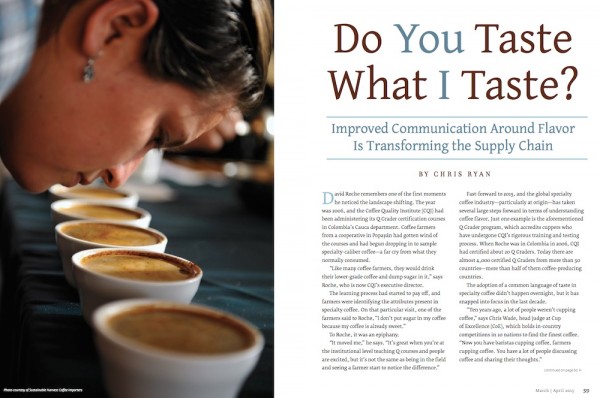The March/April 2015 issue of Roast Magazine is now shipping. If you’re not yet a Roast subscriber, become one here.
Below are previews of three of this issue’s feature stories, including a roast development study by Coffee Analysts, an exploration of Kenyan quality factors by Matt Daks, and a piece by Chris Ryan on how the communication of flavor is transforming the supply chain.
Read. Learn. Enjoy. Subscribe.
A STUDY IN ROAST LEVELS
Comparing and Contrasting Two Coffees Roasted to Five Different Levels
Story and Photos by Coffee Analysts’ Staff
Roast profile development is both an art and a science. Determining what is best for each coffee is a difficult challenge — best blend, best roast level, best brewing method, and so on. Knowing what attributes you prefer is easy; however, when developing products to sell, predicting what customers will like is more difficult. While marketing managers and consumer insight professionals have protocols for determining consumer preferences and purchase intent, coffee roasters and product developers must conduct their own technical analysis when developing new products and optimizing existing ones.
The first step is to identify success criteria: What is good, what is not good, how will the coffee be evaluated, and, perhaps most importantly, to what will the coffee be compared? Product development has two important functions: creating a product that meets the quality and profile expectations of the company, and developing a product that will be purchased and enjoyed by consumers. Ultimately, the true measure of any coffee program is beverage quality—how does it taste? Branding, promotion and merchandising will capture the first sale, but only consistent quality will keep your customers returning time after time.
TO MARKET, TO MARKET
How the Kenyan Coffee Marketing System Supports Exceptional Coffee
Story and photos by Matt Daks
Poll your closest coffee-buyer friends. Odds are, a majority will tell you their favorite place to buy green coffee, or their favorite origin to drink, is Kenya. There are several critical control points that enable Kenyan coffees to hold such a revered place in the hearts, minds and stocks of the professional coffee community.
The most obvious of these critical controls lies in the land itself. Sitting directly on the equator, Kenya enjoys ideal seasonality for coffee growing, with well-defined rainy and dry periods. Much of the nation’s coffee production is centered on the stratovolcano Mount Kenya, whose soils are rich loams primed for drainage and nutrient uptake. Small-holder plantations reach 1,800 meters above sea level and higher. This remarkable altitude provides ideal climatic conditions. Cool, clear mornings are met with the strength of the equatorial sun, which quickly raises temperatures and helps create cloud cover just above the coffee regions. As temperatures rise, cloud cover helps protect the coffee from the intensity of direct sunlight. By evening, the cloud cover is whisked away and temperatures drop quickly, slowing the maturation of fruit on the tree. The sun rises each day at 6:15 a.m. and begins to set at 6:30 p.m.
DO YOU TASTE WHAT I TASTE?
Improved Communication Around Flavor Is Transforming the Supply Chain
by Chris Ryan
David Roche remembers one of the first moments he noticed the landscape shifting. The year was 2006, and the Coffee Quality Institute (CQI) had been administering its Q Grader certification courses in Colombia’s Cauca department. Coffee farmers from a cooperative in Popayán had gotten wind of the courses and had begun dropping in to sample specialty-caliber coffee — a far cry from what they normally consumed.
“Like many coffee farmers, they would drink their lower-grade coffee and dump sugar in it,” says Roche, who is now CQI’s executive director. The learning process had started to pay off, and farmers were identifying the attributes present in specialty coffee. On that particular visit, one of the farmers said to Roche, “I don’t put sugar in my coffee because my coffee is already sweet.”
To Roche, it was an epiphany.
Nick Brown
Nick Brown is the editor of Daily Coffee News by Roast Magazine.









Comment